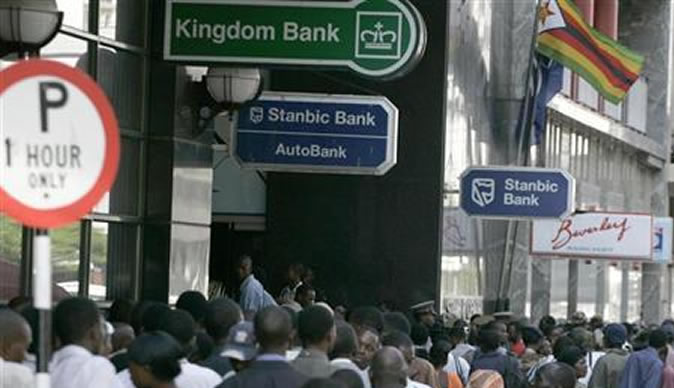BANK lending to Zimbabwe's private firms contracted from an annual growth of 28,77 percent in February 2013 to 1,5 percent due to tighter credit policies resulting from rising non-performing loans and slowdown in the growth of the deposit base, latest figures from the Reserve Bank Zimbabwe show.
RBZ said credit to private firms shrank to $3,6 billion in February, but at a faster pace compared to US$3,5 billion a month earlier.
The appetite for credit has been dwindling over the past two years due to the economic slowdown. The exorbitant lending rates have also deterred many companies from borrowing.
Zimbabwe's economy is characterised by an excessively high current account deficit, increasing trends of corporate bankruptcy, weakening Government revenue and tightening liquidity conditions that are stifling efficient credit and jobs creation.
Last month the country slumped into deflation, a phenomenon associated with downturns in the economy.
The year-on-year inflation rate for the month of February, as measured by the all items consumer price index, stood at minus 0,49 percent, shedding 0,9 percentage points on the February 2013 rate of 0,41 percent.
Claims on the private sector were in the form of loans and advances, (78,22 percent), mortgages advanced by building societies, (10,64 percent), bills discounted, (2,08 percent), bankers' acceptances, (1,54 percent) and other investments (7,53 percent).
The outstanding loans and advances were mainly to households at 19,40 percent, agriculture (19,26 percent); distribution (17,34 percent) and services (15,29 percent).
Credit to the private sector was mainly utilised for asset purchases (42,88 percent) as well as inventory build-up (34,12 percent). Loans and advances utilised for fixed investment activity have remained low, with the procurement of plant and equipment accounting for 3,82 percent and pre and post shipment financing at 0,83 percent, of total loans.
The RBZ said the sluggish performance of the economy continued to hamper robust growth rates in the broad money.
"The main sources of liquidity under the multi-currency system are exports, external lines of credit and Diaspora remittances, given that the central bank cannot inject liquidity into the economy," said the central bank.
"These have not managed to generate enough liquidity to support economic activity and achieve desirable levels of money supply growth."
Consequently, broad money registered a modest 5,46 percent annual growth in February 2014, compared to 12,91 percent over the same period last year, reflecting an increase of $208,96 million to $4 billion.
The growth in broad money was sustained by an expansion in aggregate deposits during the period under review.
Supported largely by inflows from parastatals and partly reflecting limited alternative low risk investments, long-term deposits registered a 33,75 percent annual growth during the period under review.
Over the same period, demand and savings deposits recorded annual growths of 2,21 percent and 16,19 percent respectively.
Maturities in short-term deposits resulted in this class of deposits declining by 11,07 percent during the period.
On the sources side, annual broad money growth was mainly driven by bank credit to the Government during the period under review.
This was largely due to the Government's aggressive issuance of Treasury Bills and bonds through private placements.
These instruments are of varied tenors, ranging from 92 days to 1 461 days. Unanticipated declines in the Government deposits also worsened the net credit to the Government position. On an annual basis, the Government deposits declined by 89,35 percent in December 2013, 3,6 percent in January 2014 and 0,9 percent in February.
Credit to the Government consequently rose from $153,16 million in February 2013 to $415,05 million by February 2014.
The value of transactions processed through the RTGS system in February 2014 decreased by 4 percent to $3 billion from US$3,1 billion a month earlier. Volume of transactions also registered a decrease of 4 percent to 175 092.
The total value of card based transactions decreased by 13,48 percent to $290,17 million. The value of mobile and internet-based transactions decreased by 5,06 percent, from $296,56 million in January 2014 to $281,56 million in February 2014.
The value of cheque transactions, however, doubled to $10,73 million.
- The Herald
 Parliament apologises to Mnangagwa
Parliament apologises to Mnangagwa  SA decry 'non-existent' Beitbridge border post security
SA decry 'non-existent' Beitbridge border post security  Millions celebrate Diwali festival in India
Millions celebrate Diwali festival in India  Zimbabwe's dollar stock exchange surges 45%
Zimbabwe's dollar stock exchange surges 45%  Gold edges up as traders await guidance
Gold edges up as traders await guidance  Karo Platinum Project capex rises to US$546m
Karo Platinum Project capex rises to US$546m  Young Investment Professional (YIP) Graduate Programme 2019
Young Investment Professional (YIP) Graduate Programme 2019 










 Young Investment Professional (YIP) Graduate Programme 2019
Young Investment Professional (YIP) Graduate Programme 2019
Editor's Pick